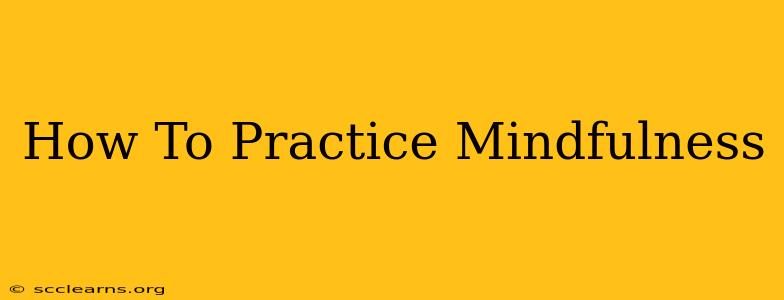Mindfulness. It's a word thrown around a lot these days, but what does it really mean, and more importantly, how do you actually practice it? This guide will walk you through simple, effective techniques to cultivate mindfulness in your daily life, helping you reduce stress, improve focus, and enhance your overall well-being.
Understanding Mindfulness: It's More Than Just Meditation
Mindfulness isn't just about sitting cross-legged and chanting "Om." While meditation is a powerful tool for mindfulness practice, it's fundamentally about paying attention to the present moment without judgment. It's about noticing your thoughts, feelings, and sensations without getting carried away by them. It's about acknowledging your experience as it is, without trying to change it or escape from it.
Think of it like this: you're walking in a forest. Instead of rushing to your destination, you pause. You notice the sunlight filtering through the leaves, the scent of pine needles, the feel of the earth beneath your feet. You're fully present, fully engaged in the experience of being in that forest. That's mindfulness.
Simple Mindfulness Practices for Beginners
Even if you're new to mindfulness, you can start incorporating these practices into your daily routine:
1. Mindful Breathing: The Foundation of Mindfulness
Mindful breathing is the cornerstone of many mindfulness practices. It's incredibly simple, yet profoundly effective:
- Find a quiet space: Sit or lie down comfortably.
- Focus on your breath: Pay attention to the sensation of your breath entering and leaving your body. Notice the rise and fall of your chest or abdomen.
- Acknowledge distractions: Your mind will wander. That's perfectly normal. Gently redirect your attention back to your breath whenever you notice your thoughts drifting.
- Practice regularly: Even a few minutes a day can make a difference. Aim for 5-10 minutes initially, gradually increasing the duration as you become more comfortable.
2. Body Scan Meditation: Connecting With Your Physical Sensations
A body scan meditation involves bringing awareness to different parts of your body, noticing any sensations without judgment.
- Lie down comfortably: Close your eyes and bring your attention to your toes.
- Notice sensations: Observe any feelings – tingling, warmth, coolness, tension, or relaxation. Simply acknowledge these sensations without trying to change them.
- Move through your body: Gradually move your attention up your body, noticing sensations in your feet, ankles, calves, knees, and so on, all the way to the top of your head.
- Be patient: This practice can be surprisingly revealing, helping you become more aware of physical tension you may not have noticed before.
3. Mindful Walking: Bringing Presence to Everyday Activities
Mindful walking transforms a mundane activity into a mindful practice:
- Pay attention to your feet: Notice the sensation of your feet making contact with the ground.
- Observe your body's movement: Feel the rhythm of your steps, the swing of your arms.
- Engage your senses: Notice the sights, sounds, and smells around you.
- Let go of judgment: Don't worry about your pace or how you look. Simply focus on the experience of walking.
4. Mindful Eating: Savor Each Bite
Mindful eating involves paying close attention to the sensory experience of food:
- Choose a single food item: Focus on one food, like a piece of fruit or a bite of chocolate.
- Observe its appearance: Notice its color, texture, and shape.
- Smell the aroma: Inhale deeply, appreciating the scent.
- Taste slowly: Take small bites and chew thoroughly, paying attention to the flavors and textures.
- Notice the sensations: Observe the feeling of the food in your mouth and how it makes you feel.
Benefits of Practicing Mindfulness
Regular mindfulness practice can offer a wide range of benefits, including:
- Reduced stress and anxiety: Mindfulness helps to calm the nervous system and reduce the impact of stress hormones.
- Improved focus and concentration: By training your mind to stay present, you improve your ability to focus on tasks.
- Increased self-awareness: Mindfulness helps you become more aware of your thoughts, feelings, and behaviors.
- Enhanced emotional regulation: You learn to observe your emotions without being overwhelmed by them.
- Better sleep: Mindfulness practices can promote relaxation and improve sleep quality.
Incorporating Mindfulness into Your Daily Life
The key to making mindfulness a part of your life is consistency. Start small, choosing one or two practices to focus on initially. Gradually incorporate more practices as you become more comfortable. Remember, it's a journey, not a destination. Be patient with yourself, and enjoy the process of discovering the peace and clarity that mindfulness can bring. The more you practice, the more natural and effortless it will become.

